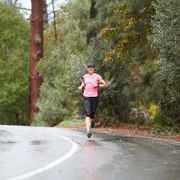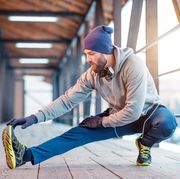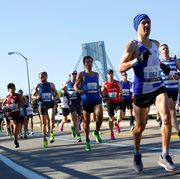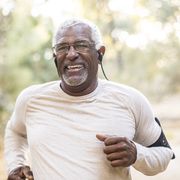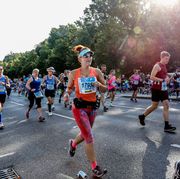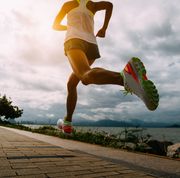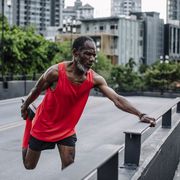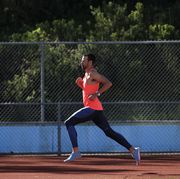1) GET NEW SHOES
To get the full benefits of natural running or a barefoot style of running, look for minimalist shoes with a few key characteristics. First, the shoes should be lightweight, low to the ground and flexible, have a limited heel-to-toe drop and have a thin layer of medium-firm cushioning under the forefoot. (Some minimalist runners prefer a slightly more cushy shoe for longer runs, but even a thin layer of soft foam under the midfoot and forefoot will dampen the foot's ability to feel the ground and respond accurately, particularly for faster-paced efforts and races.)
By nature, minimalist shoes offer little to no support and no stability control, based on the belief that the foot in an efficient gait can naturally off set much of the rolling (pronation/supination) that would occur after a heavy heel-strike gait. Essentially, minimalist shoes offer just enough protection from the pavement while letting the foot move naturally through a stride cycle.
Many traditional training shoes put the foot 22-24mm off the ground in the heel and 10-15mm off the ground in the forefoot, and the difference between the two -- typically 12-14mm in traditional training shoes -- creates a forward-leaning slope, designed to reduce stress on the Achilles. Minimalist shoes trend toward being much more level (a 2-10mm slope) with the assumption that the runner will land on the midfoot and use the natural cushioning of the arch, thus the built-up heel only adds weight and gets in the way of an efficient stride.
But understand that there are varying degrees of minimalist shoes. For example, a Pearl Izumi Streak has a 10mm heel-toe drop (20-10mm), a Brooks Green Silence has an 8mm drop and the Newton Gravity Trainer has a 3mm drop. Other current shoes within the minimalist realm include the New Balance 100, ASICS GEL-Hyper Speed 4, adidas adiZero Ozweego 365 CLIMACOOL, ECCO BIOM A, and K-Swiss Ultra-Natural Run II S.
2) TRANSITION SLOWLY
Even if you're a veteran runner who is used to running in lightweight shoes, you should take caution when transitioning to a more minimalist type of shoe. You're bound to engage muscles in your feet, lower legs and core differently than you're used to, partially because you'll be landing less on your heel with a braking angle and more near your midfoot with a more level landing. Th at will require a period of adjustment, especially if you haven't been doing general strength or dynamic strength exercises, says Mark Cucuzzella, M.D., a 2:24 marathoner and family practice doctor and faculty member of West Virginia University who has done running gait analysis to study running injuries.
Plus, while your core will no longer be working so hard to keep your upper body balanced because you'll be running in a more natural position without a built-up heel, your body will have to adjust slightly for the newfound positioning. Elite coaches and Running Times contributors Jay Johnson (runningdvds.com) and Greg McMillan (mcmillanrunn ing.com) have both produced strength exercise videos geared toward distance runners. Michael Yessis' Explosive Running presents many resistanceband exercises targeted at improving elements of your stride. A regular dedication to general and dynamic strength is crucial for anyone running in minimalist shoes.
Should you eventually be running all of your miles in minimalist shoes? Purists will say yes, of course, but contrarians argue that this can lead to injuries for runners who are larger or not optimally fit. As you transition, consider using your minimalist shoes for short and fast workouts and wait until you're strong enough to crank out that 14-mile negativesplit marathon simulation run.
3) RUN BAREFOOT -- BRIEFLY
Barefoot running can be very useful in your transition to minimalist running, but it should be done safely under controlled circumstances. Physical therapist Mark Plaatjes, co-owner of Colorado's Boulder Running Company, doesn't condone a full-time minimalist approach for most runners, but says even if you're not switching to minimalist shoes, consistently running barefoot strides after workouts is a good way to help build dynamic strength in the feet and lower legs. The key is to focus on good form: light foot placements that don't entail heavy braking, a short, compact arm swing, and an upright, but slightly forward-leaning posture that allows your center of mass to be in front of your footsteps.
Consider ending your run where you can run on soft grass -- a park, the edge of a public golf course or the infield of a high school track -- and do a handful of buildup strides of 50 to 75m reaching 80 to 90 percent effort two-thirds of the way through. Start with a few during your first week and ease your way up to about six to eight after a few weeks, extending the length and your speed slightly but always focusing on optimally efficient running form.
Another form of barefoot strength-building can come through slow heel-toe walks on grass or through sand -- either on a beach or the long jump pit of a local high school track. Start a stride by pushing your heel into the sand and then forcefully rolling through the midfoot to the ball of the foot and then extending up on the toes. The resistance from the soft surface or sand will require more muscular exertion and, if done regularly, will help build foot and ankle strength.
4) DO FORM DRILLS
Boulder, Colo.-based running coach Bobby McGee is one of many form gurus who preach the need to do form drills before workouts when you're fresh as a way to develop efficient running form during a race when you're battling fatigue. By repeatedly working on the tenets of good running form -- light foot placements, high stride cadence, compact arm carriage, upright, forward-leaning posture -- you'll be able to instill in your brain and the rest of your body how your body should be functioning in the latter stages of a race, he says.
Drills come in many varieties and you can make up your own to make things more fun, but a few common ones include high-knee strides (alternating every other stride or every third stride with a "knee kick"), butt kicks (an exaggerated rear leg extension in which you alternate kicking yourself in the hind quarters) quick feet (doing as many fast, short strides as possible in about 20-30m) and acceleration strides (50-60m buildup sprints that top out at about 90 percent). Every drill should stress or accentuate some aspect of good form, even if exaggerated during the drill. Drills should be done several times per week.
Barefoot-style running shoes
Nike was the first to mass produce minimalist running shoes specifically designed to work with a natural or "barefoot-style" running gait in 2004 with the introduction of its Free line of shoes. It continues to update three models that offer varying levels of foam cushioning, from next-to-nothing in the Free 3.0 v2 to moderate amount of foam in the Free 5.0 v4 to fairly thickly cushioned Free Everyday+ 2. Free shoes incorporate minimal outsole (only small pads of durable rubber in high-wear areas) and have a lightweight foam midsole that can flex according to the dynamic movement of a foot; however, they maintain a significant heel-to-toe drop and support under the arch like traditional running shoes.
Since its inception in 2007, Newton has developed lightweight training and racing shoes with minimal heel geometry and an almost level heel-toe slope that allows a runner to avoid heel striking (and instead land near the ball of the foot) and utilize its innovative Action/Reaction Technology that captures downward energy and channels it into forward propulsion.
This entrepreneurial effort from barefoot running proponent David Sypniewski is expected to launch later this year. The shoe will include a rounded minimal heel, an ultra-thin midsole/outsole with the same depth from heel-to-toe, an extra-wide toe box and adjustable lacing for a customizable fit.
NIKE FREE



